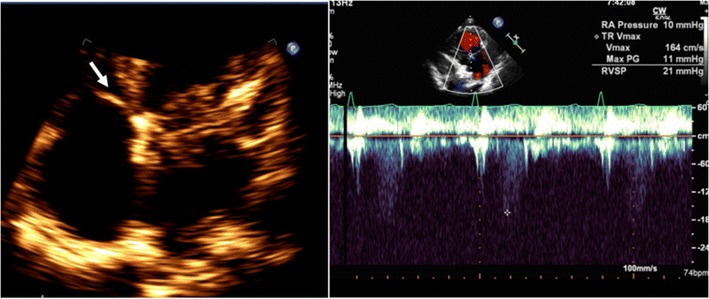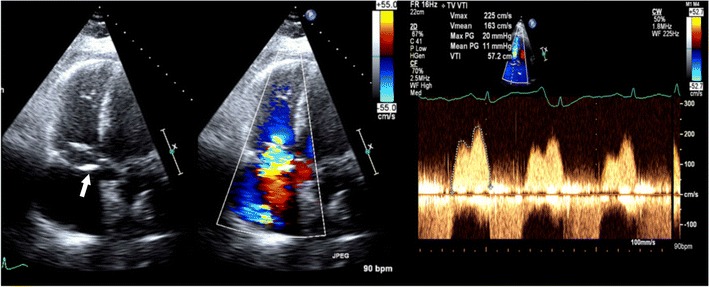Tricuspid stenosis diagnostic study of choice: Difference between revisions
| Line 21: | Line 21: | ||
[[File:Normal echocardiographic appearance of tricuspid valve.jpg|center|thumb|709x709px|Normal echocardiographic appearance of tricuspid valve (''arrow'') and wave pattern. Case courtesy by Soham Shah et al<ref>{{Cite web|url=https://www.ncbi.nlm.nih.gov/pmc/articles/PMC5028338/|title=Multimodal imaging of the tricuspid valve: normal appearance and pathological entities|last=|first=|date=|website=|archive-url=|archive-date=|dead-url=|access-date=}}</ref>]] | [[File:Normal echocardiographic appearance of tricuspid valve.jpg|center|thumb|709x709px|Normal echocardiographic appearance of tricuspid valve (''arrow'') and wave pattern. Case courtesy by Soham Shah et al<ref>{{Cite web|url=https://www.ncbi.nlm.nih.gov/pmc/articles/PMC5028338/|title=Multimodal imaging of the tricuspid valve: normal appearance and pathological entities|last=|first=|date=|website=|archive-url=|archive-date=|dead-url=|access-date=}}</ref>]] | ||
[[File:Tricuspid stenosis in echocardiography.jpg|alt=Tricuspid stenosis in echocardiography|center|thumb|709x709px|Tricuspid stenosis in echocardiography. 2D and color Doppler images in a patient with antiphospholipid antibody syndrome shows thickening of the valve leaflets (''arrow'') and continuous-wave Doppler with a mean pressure gradient of 11 mmHg, which is consistent with severe tricuspid stenosis. Case courtesy by Soham Shah et al<ref>{{Cite web|url=https://www.ncbi.nlm.nih.gov/pmc/articles/PMC5028338/|title=Multimodal imaging of the tricuspid valve: normal appearance and pathological entities|last=|first=|date=|website=|archive-url=|archive-date=|dead-url=|access-date=}}</ref>]]<br /> | [[File:Tricuspid stenosis in echocardiography.jpg|alt=Tricuspid stenosis in echocardiography|center|thumb|709x709px|Tricuspid stenosis in echocardiography. 2D and color Doppler images in a patient with antiphospholipid antibody syndrome shows thickening of the valve leaflets (''arrow'') and continuous-wave Doppler with a mean pressure gradient of 11 mmHg, which is consistent with severe tricuspid stenosis. Case courtesy by Soham Shah et al<ref>{{Cite web|url=https://www.ncbi.nlm.nih.gov/pmc/articles/PMC5028338/|title=Multimodal imaging of the tricuspid valve: normal appearance and pathological entities|last=|first=|date=|website=|archive-url=|archive-date=|dead-url=|access-date=}}</ref>]]<br /> | ||
==References== | ==References== | ||
{{Reflist|2}} | {{Reflist|2}} | ||
{{WH}} | {{WH}} | ||
{{WS}} | {{WS}} | ||
Revision as of 11:46, 20 March 2020
|
Tricuspid stenosis Microchapters |
|
Diagnosis |
|---|
|
Treatment |
|
Case Studies |
|
Tricuspid stenosis diagnostic study of choice On the Web |
|
American Roentgen Ray Society Images of Tricuspid stenosis diagnostic study of choice |
|
Risk calculators and risk factors for Tricuspid stenosis diagnostic study of choice |
Editor-In-Chief: C. Michael Gibson, M.S., M.D. [1]; Associate Editor(s)-in-Chief: Vamsikrishna Gunnam M.B.B.S [2]
Overview
Tricuspid stenosis (TS) is characterized by structural changes in the tricuspid valve. The most common cause of tricuspid stenosis (TS) is rheumatic heart disease. Echocardiography is the gold standard test for the diagnosis of tricuspid stenosis which gives tricuspid peak inflow velocity and degree of thickening of tricuspid valve leaflets.
Diagnostic Study of Choice
Study of choice
- Echocardiography is the gold standard test for the diagnosis of tricuspid stenosis.
- The following result of echocardiography is confirmatory of tricuspid stenosis:[1][2][3]
- The degree of thickening of tricuspid valve leaflets
- Calcification of tricuspid valve leaflets
- Limited leaflet mobility of tricuspid valve leaflets
- Reduced separation of the tricuspid valve leaflet tips
- Diastolic doming of the tricuspid valve
- Echocardiography gives the degree of fusion of the commissures and chordae tendineae of the tricuspid valve


References
- ↑ Morgan, Jacob R.; Forker, Alan D.; Coates, J. R.; Myers, W. S. (1971). "Isolated Tricuspid Stenosis". Circulation. 44 (4): 729–732. doi:10.1161/01.CIR.44.4.729. ISSN 0009-7322.
- ↑ Finnegan, P; Abrams, L D (1973). "Isolated tricuspid stenosis". Heart. 35 (11): 1207–1210. doi:10.1136/hrt.35.11.1207. ISSN 1355-6037.
- ↑ Baumgartner, Helmut; Hung, Judy; Bermejo, Javier; Chambers, John B.; Evangelista, Arturo; Griffin, Brian P.; Iung, Bernard; Otto, Catherine M.; Pellikka, Patricia A.; Quiñones, Miguel (2009). "Echocardiographic Assessment of Valve Stenosis: EAE/ASE Recommendations for Clinical Practice". Journal of the American Society of Echocardiography. 22 (1): 1–23. doi:10.1016/j.echo.2008.11.029. ISSN 0894-7317.
- ↑ "Multimodal imaging of the tricuspid valve: normal appearance and pathological entities".
- ↑ "Multimodal imaging of the tricuspid valve: normal appearance and pathological entities".